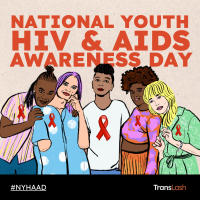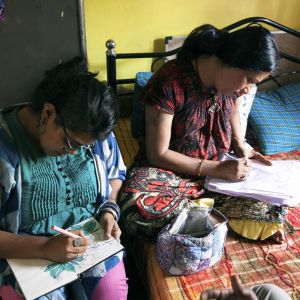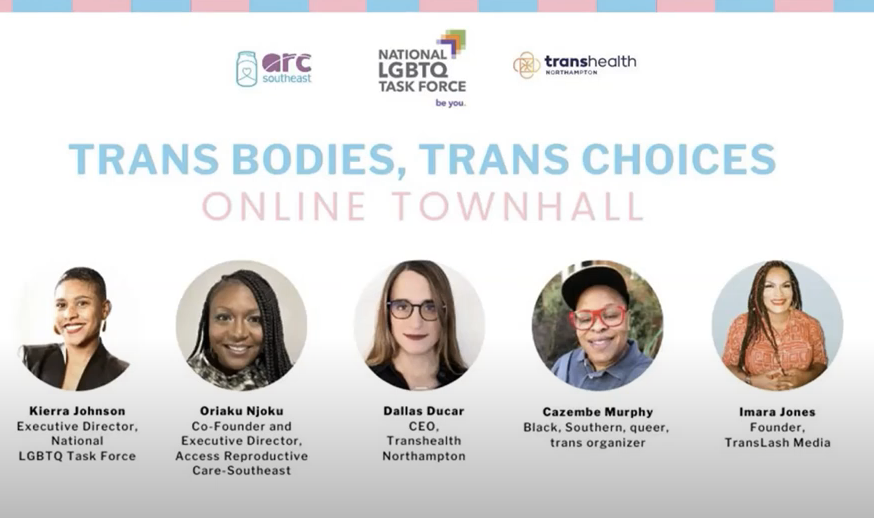by Alex Petkanas
This op-ed is the first in a series of pieces through our TransLash News and Narrative platform, launching in 2022. Subscribe for alerts. For more #TransBodiesTransChoices content, explore our film series guides for My Abortion Saved My Life and I Didn’t Think I’d Make It.
My own experiences with annual gynecological exams as a trans person have been consistently negative. I had grown accustomed to the base level of discomfort and fear—until my most recent visit. Feeling out of place usually starts in waiting rooms or during intakes. While gender nonconforming language in waiting room literature and on intake forms are not guarantees of trans competent care, these introductory elements can either include me or alienate me. At many offices, I was required to select “male” or “female” for my gender, leaving me totally unsure of what to do. I would be asked, “If you’re a woman, could you be pregnant?” The question made me feel invisible because I am not a woman, but I still have the ability to get pregnant. At the visit where I felt safest, the waiting room was full of information for people of all genders. The forms allowed me to indicate that I am trans and nonbinary, and medical questions related to specific body parts—not to gender.
During regular intakes, I would typically be asked about my last menstrual cycle. Even before starting testosterone I had a highly irregular cycle and felt deep dysphoria about my period. When explaining why I didn’t know when the last period was, nurses often seemed surprised or annoyed. However, during my most recent visit where I felt welcomed, the person I met with asked questions about my experiences and needs as a trans person. She had a clear understanding of testosterone and simply asked if I ever bled during my menstrual cycle anymore. It was the first time I felt like I was going to get gynecological care that made my body feel accepted.
But OBGYN visits weren’t the triggers for my dysphoria.
It was years before I realized that I was having dysphoria about my chest. This is why breast exams made me so uncomfortable. Every visit, without fail, I would laugh nervously and start to feel nauseated while the person doing my exam pressed their hands into my breasts. I would apologize for how nervous I was, but the examiner would say “you’re just ticklish,” or ignore what I was saying completely which left me even more anxious. This pattern continued after I came out. No providers ever offered any kind of solution or support.
During my recent gender-affirming visit, the registered nurse had me place my hand on top of hers and take deep breaths throughout the breast exam to lessen the sensation of surprise. For the first time, my body relaxed. I was able to get through it without any nausea or uncomfortable laughter. When I realized how simple the solution to my anxiety was I felt relieved and disappointed in every other provider I had been to. For trans people who often experience body dysphoria and have high rates of sexual trauma, going to a gynecologist for an annual exam can be anywhere from triggering to downright retraumatizing. According to a 2015 study of over 27,000 trans people across the United States, 47% of respondents had been sexually assaulted in their lifetime. One-third of these respondents also reported having a negative experience with a health care provider as a result of being trans. While I don’t know exactly where this nurse learned trans-affirming and trauma-informed approaches, there are plenty of resources that provide information on trans-specific health care needs and alternatives to standard testing procedures.
In a study referenced in the American College of Obstetricians and Gynecologists’ page on Health Care for Transgender and Gender Diverse Individuals, transmasculine patients expressed an overwhelming preference (90%+) for self-collected vaginal swabs. A training module from Michigan Medicine describes some of the potential impacts of hormones and encourages providers to discuss options for testing with patients, like self-insertion of the speculum. The University of California San Francisco Gender Affirming Health Program provides a variety of techniques for providers to establish trust and perform pelvic exams, like using a mirror so patients can directly observe and checking with patients about their preferred language for their body parts. Additionally, examiners should clearly communicate what they are going to do before interacting with patients. Patients should have an opportunity to process these requests and verbally consent to each part of an exam.
The registered nurse who provided a safe and comfortable exam for me demonstrated that she had a comprehensive clinical understanding of my needs, but also showed patience and empathy in her approach. She took time to listen to and acknowledge my previous negative experiences, and when she did, it felt like she made an effort to begin healing the wounds caused by medical institutions. She had a conversation with me about how we could proceed, asked me if I felt ready to move forward, and reminded me that I could stop the exam at any time.
This is another crucial element of trans-affirming and trauma-informed care.
Medical professionals should slow down and clearly ask what the patient’s experiences with medical exams have been in the past. While some patients may know exactly what they need and be able to express it, others may not. With a strong understanding of trans-specific and trauma-informed health care, medical professionals can provide positive care to those who do not have specific requests by using good communication and giving as much control to the patient as possible throughout the exam. The opportunity to discuss safety at home is important, but some patients may also need the support of a partner, relative, close friend in the room, or on the phone.
The stakes are high when gender-affirming care is inaccessible. Annual breast and pelvic exams are opportunities to screen for multiple types of cancer in addition to STD testing. When these are not caught early, they can develop into issues that are much harder to treat. It is essential that medical professionals stay up to date on their continuing education.
For the safety and wellness of trans people, providers must adopt a trans-affirming and trauma-informed approach to annual exams because it can save our lives.
Trans Bodies, Trans Choices: Resources
Trans Bodies, Trans Choices Films
- Watch I Didn’t Think I’d Make It here and access the transcript.
- Watch My Abortion Saved My Life here and access the transcript.
- Watch the Trans Bodies, Trans Choices: Having a Baby IG Live replay here and access the transcript.
- Watch the #TransBodiesTransChoices Online Townhall replay here and access the transcript.
Getting an Abortion
- Under 18 and need an abortion + free legal representation for judicial bypass? Call or text Jane’s Due Process: 1-866-999-5263
- The National Network of Abortion Funds connects abortion seekers with grassroots organizations that can support financial and logistical needs here
- Tips on how to choose a good abortion provider and questions to ask a clinic
- The Brigid Alliance arranges and funds travel, along with related needs, to support individuals across the country who are forced to travel for later abortion care.
For Clinicians and Providers
- Trans-Inclusive Abortion Services: a manual for providers on operationalizing trans-incluslive policies and practices in an abortion setting
Calls to Action
- Sign on and Demand #AbortionWithinReach: Abortion funds have come together to deliver an unprecedented bold statement, explicitly identifying what it means for abortion to be truly accessible for our callers. As we shine a light on these demands, we also want to spotlight independent clinics, who are our partners on the front lines giving support and care to abortion seekers. Independent clinics perform the majority of abortions in the U.S., and show up big as plaintiffs in the monumental cases of the past few years.
- Expand the Supreme Court & Save Abortion Rights. Sign the petition here.
- Urge federal elected officials to end the Hyde Amendment, the Global Gag Rule, and the Helms Amendment. Learn more and take action to expressly urge support for the EACH Act, the Global Health, Empowerment, & Rights Act, and the Abortion is Healthcare Everywhere Act.
- Invest in abortion clinics, especially community-led health care facilities.
- Talk about abortion! Change culture and shift stigma through powerful, values-based conversations. We believe dialogue, storytelling, and intentional conversations are powerful tools to organize and strengthen our movement. This guide for heart-to-heart abortion conversations from NNAF and this toolkit from Chicago Abortion Fund will support you to hold a small group gathering, house party, or action space where you can invite your friends, family, and acquaintances into meaningful conversations about abortion, issues that relate to abortion, and why you support abortion funds.
- Support the Black reproductive justice policy agenda, which outlines proactive policy solutions to address issues at the intersections of race, gender, class, sexual orientation, and gender identity within the situational impacts of economics, politics and culture that make up the lived experiences of Black women, femmes, girls and gender-expansive individuals in the United States.
- Invest in long-term sustainable models of care that supplement existing structures of support and center the expertise of those who have been laying this groundwork for years so that communities have reliable support systems that contribute to one’s current and future ability to thrive.
- We urge all individuals knowledgeable about a person’s reproductive choices to make a commitment to not – under any circumstances – punish, criminalize or report any person for any pregnancy decision or seeking medical assistance for a decision. This includes abortion funders, public health authorities, clinicians, law enforcement, prosecutors, and community members.
Resources on Pregnancy as a Transgender Person
- The Queer & Trans People of Color Birthwerq Project
- BOOK: How We Do Family: From Adoption to Trans Pregnancy, What We Learned about Love and LGBTQ Parenthood by Trystan Reese
- Meet the birth workers helping transgender parents bring babies into the world and break stigmas.
- Preparing for Pregnancy as a Non-Binary Person (Family Equality)
- Transgender Pregnancy: Moving Past Misconceptions (Healthline)
- From erasure to opportunity: a qualitative study of the experiences of transgender men around pregnancy and recommendations for providers.
- TransLash Podcast, Episode 13 ‘Trans Love’ feat. Precious Brady-Davis, who appeared with her husband Myles on the TLC special, My Pregnant Husband.
- If a transgender man stops taking his testosterone, his menstrual cycle often returns, reportedly within about 6 months.
- Explore TransLash’s guide for trans dads and TGNC parents.
‘Trans Bodies, Trans Choices’ Press
- Teen Vogue [EXCLUSIVE]
Featured image courtesy of Broadly’s Gender Spectrum Collection.
Alex is a trans and sober 29-year-old living in Alaska with their partner, their cat, and their dog. After graduating from law school and getting licensed as an attorney during the pandemic, Alex quit working as a lawyer. Since then, Alex has started working on a local farm, writing, and providing child care. Follow Alex on Twitter: @alexpetkanas
Did you find this resource helpful? Consider supporting TransLash today with a tax-deductible donation.
























